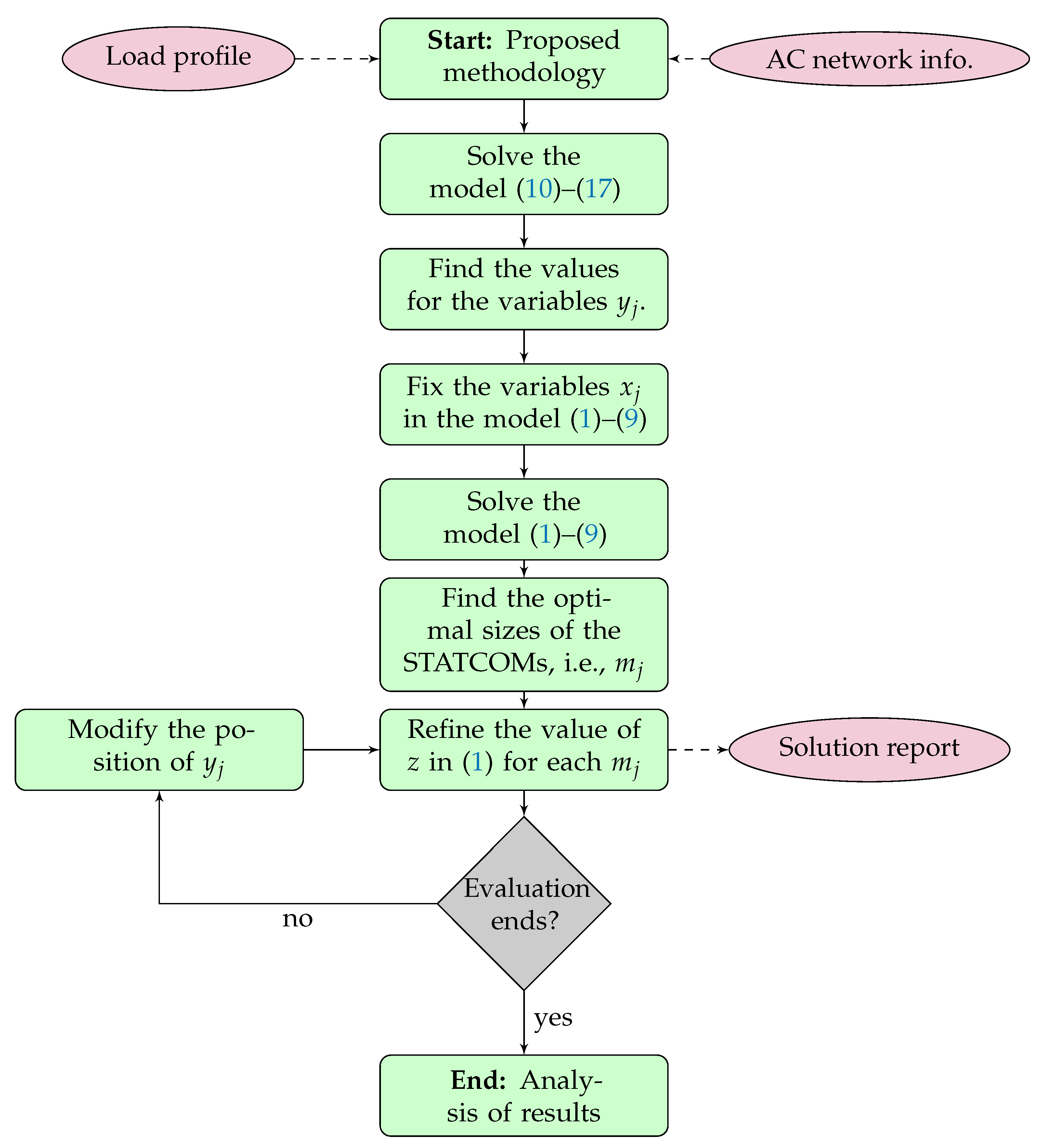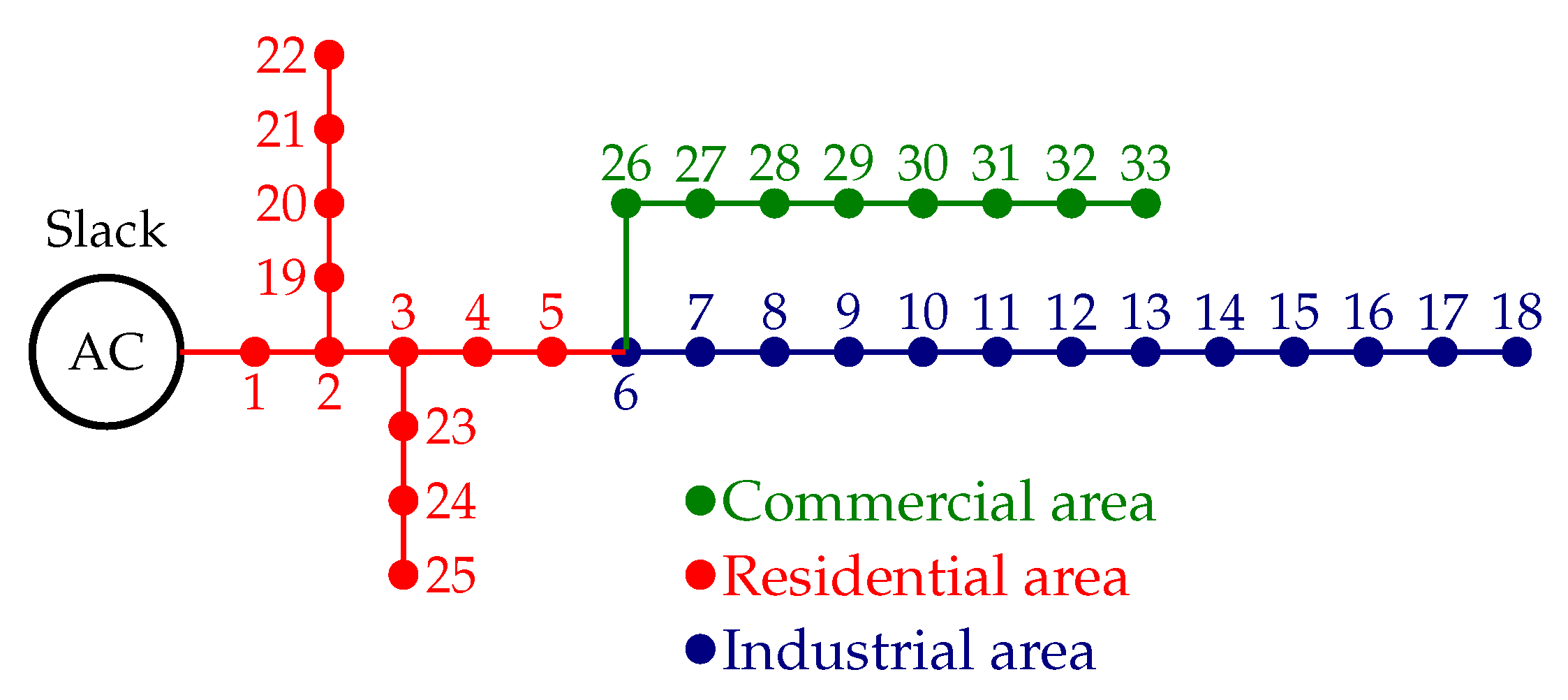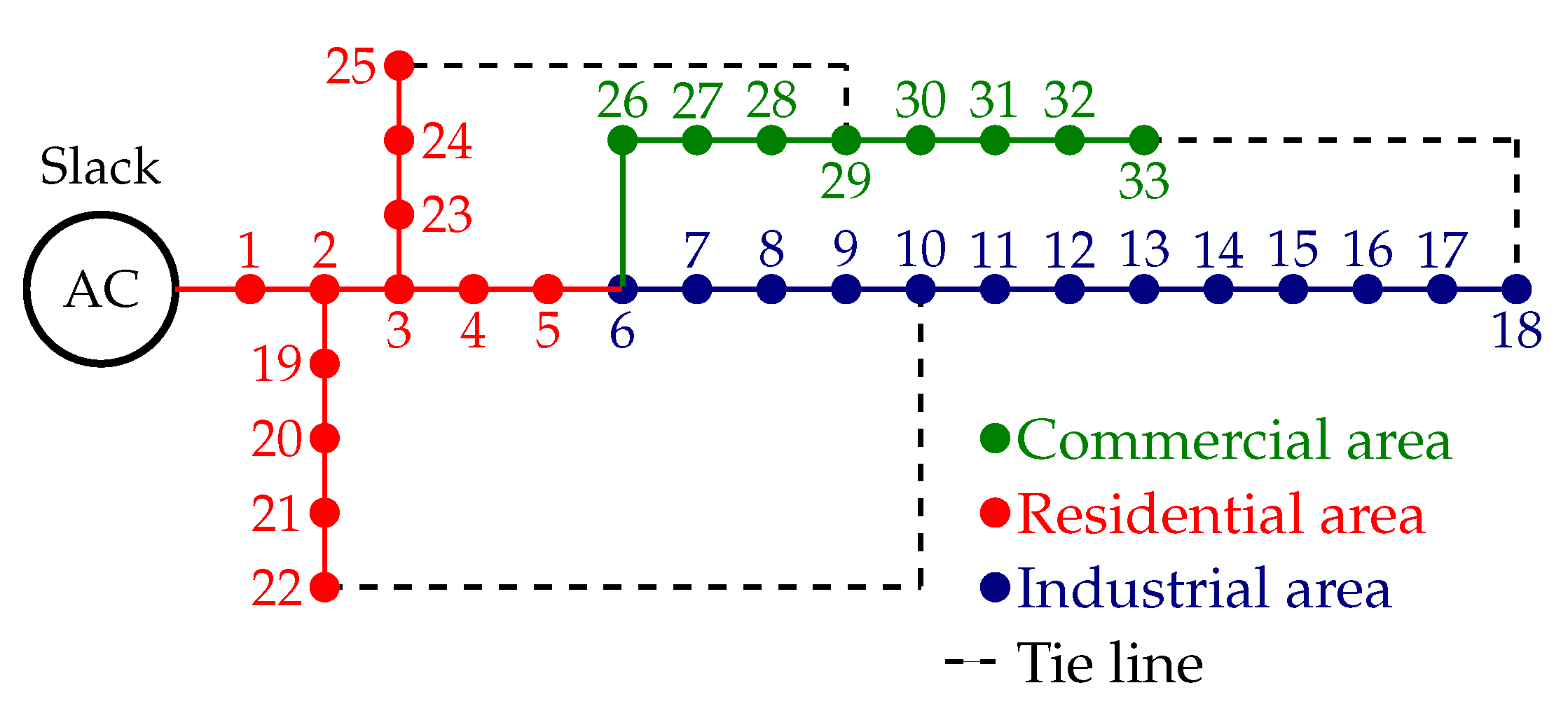1. Introduction
Electric distribution networks are one of the main components of electric energy systems, which are entrusted with interfacing transmission/sub-transmission systems at substations with end-users through a medium-voltage network [
1]. Distribution grids typically operate between 1 and 25 kV, and they have be equivalent loads between 3 MVA and 10 MVA. These grids can also cover a few square kilometers in urban areas and hundreds of square kilometers in rural areas [
2]. From a construction perspective, distribution networks are typically configured with a radial structure, i.e., there is one and only one path between each node and the substation bus [
3]. Due to this electrical configuration, electric distribution grids have energy losses between 6% and 18% of the energy input at the substation terminal, which is very high when compared to high-voltage power systems, whose losses are about 2% [
4].
To reduce the energy losses in distribution networks, there are different technical approaches reported in the literature, as well as those implemented by distribution companies, both with excellent results. These approaches include (i) grid reconfiguration [
5], (ii) phase-balancing [
6], and (iii) shunt reactive power compensation [
7].
The reconfiguration strategy in distribution networks is a classical approach to minimizing grid power losses. This strategy requires the presence of tie-lines with reconfigurable devices (normally-open reclosers) in the distribution system, which work in conjunction with normally closed reclosers in order to modify the grid structure under particular load conditions [
8]. Grid reconfiguration allows for excellent energy loss reduction indicators. However, it requires significant investments in protection devices and new tie-lines. In addition, the dynamic reconfiguration of distribution networks implies the use of advanced protective coordination schemes, which also increases the total grid operating costs [
9].
The implementation of a phase-balancing approach for power loss reduction in distribution networks is a methodology only applicable to three-phase asymmetric networks, i.e., distribution networks with single-, two-, and three-phase loads with star or delta connections [
10]. This method consists of redistributing all the load connections in all the nodes of the network, with the purpose of balancing load consumption in order to make three-phase systems operate as fully balanced systems by a close margin [
11]. The phase-balancing approach is an efficient and low-cost approach for reducing energy losses in distribution networks. However, its final solution is completely dependent on load profiles, which implies that, if there are significant variations, making the phase-balancing approach efficient will require a dynamic implementation, i.e., using reconfigurable devices at each node, which will considerably increase the final costs [
12].
Reactive power compensation in distribution grids can be implemented with fixed-step or variable-step capacitor banks, which constitutes a low-cost solution with important energy losses reduction effects, as well as good improvements in the grid voltage profiles [
13]. However, the main problem with this solution is associated with the variability of load consumption, which implies that the injection of reactive power with fixed values is not the best option for compensating the variability of the energy losses during a typical day of operation [
14]. An additional device used in distribution networks for shunt reactive power compensation is Distribution Static Compensators (D-STATCOMs), which are devices based on power electronics that have the ability to provide variable reactive power as a function of the grid requirements [
15]. These devices need additional investments when compared with capacitor banks. However, their dynamic behavior regarding reactive power injection allows for better reductions in the expected annual grid energy losses, which makes these devices attractive for installation in modern distribution networks.
This research focuses on shunt reactive power injection in distribution networks using D-STATCOMs, as their dynamic behavior (dispatchable reactive power characteristics) makes these devices an excellent alternative for minimizing the annual expected energy losses in distribution networks with residential, industrial, and commercial users [
16]. In the specialized literature, there are multiple approaches regarding D-STATCOMs and their optimal integration in distribution networks.
The problem regarding the optimal installation and sizing of D-STATCOMs was thoroughly studied by the authors of [
17], who presented a complete review of the state of the art and outlined different methodologies for locating these devices within a distribution network. These methodologies include sensitive nodal analysis, heuristic and metaheuristic approaches, artificial neural networks, and some combinations. The authors of [
18] presented the application of a discrete-continuous version of the particle swarm optimization method in order to locate and size D-STATCOMs in radial distribution networks composed of 33 and 69 nodes. Numerical results demonstrated the effectiveness of the proposed approach when compared with the vortex search algorithm, the genetic-based optimization approach, and two exact MINLP solvers available in the General Algebraic Modeling System (GAMS) software. In [
19], the authors discussed the effect of the simultaneous integration of dispersed generators and D-STATCOMs in the reactive power transference capabilities of the distribution grid. The authors located and sized both devices using sensitivity-based approaches, with the main goal of maximizing the reactive loadability of the grid by keeping voltage profiles within an acceptable range of operation. The authors of [
16] presented the application of the discrete-continuous version of the salp swarm algorithm to locate and size D-STATCOMs in radial and meshed distribution networks in order minimize the annual expected energy losses costs while considering the investments made in compensation devices. Numerical results in the IEEE 33-bus grid, which considered residential, industrial, and commercial loads, demonstrated the effectiveness of the proposed approach when compared to the MINLP solvers available in the GAMS software. In [
20], the authors explored the problem regarding the optimal siting and sizing of D-STATCOMs in radial distribution networks while aiming to minimize the grid power losses in all the distribution branches. To select the size and location of these devices, an analytical method and the particle swarm optimization technique were employed, with promissory results in test feeders composed of 12 and 69 nodes. The authors of [
21] presented the application of a mixed-integer conic reformulation to locate and size D-STATCOMs in distribution networks. The proposed formulation was tested in the IEEE 33-bus grid, but it is only applicable to purely radial distribution networks, since it is based on the branch power flow approach presented in [
22]. In [
23], the authors explored the aforementioned problem by using a probabilistic approach and sensitive factors. The main goal of this research was improving the voltage stability margin throughout the distribution network. Monte Carlo simulations demonstrated the effectiveness of the proposed approach in the IEEE 85-bus system. In [
24], an analytical approach to locate and size D-STATCOMs and dispersed sources was presented. The authors used the stability index and the loss-sensitive factor in order to determine the best locations and sizes for the dispersed generators and D-STATCOMs. Numerical results in the IEEE 33-bus grid demonstrated the effectiveness of the proposed approach with regard to the comparison between the benchmark case and the final power losses and voltage profiles. Other optimization methods available in the current literature to locate and size D-STATCOMs in distribution networks include the fuzzy-lightning search algorithm [
25], the differential evolution algorithm [
26], the whale optimization algorithm [
27], the bat optimization algorithm [
28], the tabu search algorithm, the ant colony optimizer [
29], and the ant lion optimizer [
30], among others.
Table 1 summarizes the main approaches reported in the current literature to address the problem of optimally placing and sizing D-STATCOMs in distribution networks.
The main characteristics of the summarized optimization approaches for locating and sizing D-STATCOMs in distribution networks are the following: (i) most of the literature reports focus on the power losses minimization and voltage profile improvements; (ii) three tendencies to solve the optimization problem can be identified, i.e., selection of nodes and sizes using sensitive index, the application of combinatorial optimization methods, and the application of convex-based approaches; and (iii) the problem regarding location and sizes of D-STATCOMs continues being a studied optimization problem with recent publications in the last decade. Based on the above, this research makes the following contributions:
The proposal of a new two-stage approach to the problem under study by using a mixed-integer convex model to select the optimal nodes for locating the D-STATCOMs and a nonlinear programming model to determine their optimal sizes.
The applicability of the proposed modeling to radial and meshed distribution grids without any modification in their mathematical structure, with the main advantage that different users are considered, i.e., residential, industrial, and commercial loads.
It is worth mentioning that this research focuses on using D-STATCOMs in radial and meshed distribution networks at medium-voltage levels while aiming to minimize the annual expected energy losses costs and considering D-STATCOM investments in the objective function. However, the maintenance and operating costs of the D-STATCOMs are neglected in this research, as these devices require very few revisions/interventions during their useful life, which can be between 15 and 25 years. In addition, this research only considers the typical daily load behavior of a work day that includes residential, industrial, and commercial users connected to the distribution grid. This was based on the fact that the distribution grid is located in a tropical country, i.e., between the tropics of Capricorn and Cancer, as is the case of Colombia [
16]. Notwithstanding, more research is needed to include the seasonal behavior of the demand in the expected placement and sizing of D-STATCOMs.
The remainder of this document is structured as follows:
Section 2 presents the exact mathematical modeling of the studied problem in its general mixed-integer nonlinear programming (MINLP) form,
Section 3 presents the main considerations for converting the MINLP formulation into a mixed-integer convex equivalent, in order to determine the nodes where the D-STATCOMs will be located;
Section 4 describes the solution methodology regarding the selection of the nodes and the optimal sizes of the D-STATCOMs by using a nonlinear programming evaluator;
Section 5 shows the main characteristics of the distribution system considered in this study, i.e., the IEEE 33-bus grid, along with its radial and meshed configurations and its load distribution per area;
Section 6 presents all the numerical validations of the proposed solution methodology, as well as its comparison with metaheuristic optimization methods; and
Section 7 lists the main conclusions derived from this research, as well as some possible future works.
2. Exact MINLP Formulation
The problem regarding the optimal placement and sizing of D-STATCOMs in electric distribution networks involves a MINLP model that combines binary variables regarding the nodes where the D-STATCOMs will be located and continuous variables regarding voltages, currents, power flows, and D-STATCOM sizes, among others. The exact MINLP model that represents the studied problem is presented in Equations (
1)–(9).
where
z represents the objective function value regarding the expected annual operating costs of the distribution grid,
corresponds to the average energy cost for the distribution system’s operator,
T represents the number of days in an ordinary year,
means the resistive effect associated with the distribution line
l,
and
are the real and imaginary components of the current flowing through the line
l in the period of time
h,
represents the period of time where electrical variables are assumed to be constant,
is the cost factor regarding the installation of the D-STATCOMs,
means the size of a D-STATCOM installed at node
j, and
,
, and
correspond to the cubic, quadratic, and linear cost coefficients associated with the investments made in D-STATCOMs, respectively.
Remark 1. The selection of the cubic function that represents the expected investment costs of the D-STATCOMs presented in the second part of Equation (1) was made based on the recommendations made by the authors of [31,37], who presented a general formulation for integrating D-STATCOMs while considering their annualized investment costs and a planning period of 5 years.
where
corresponds to the active power generation in the slack source connected at node
j in the period of time
h,
represents the demanded active power at node
j in the period of time
h,
and
are the real and imaginary parts of the voltage profiles at node
j for each period of time,
corresponds to the component of the node-to-branch matrix that relates the node
j with the line
l,
means the reactive power injection in the slack source at node
j in the period of time
h,
represents the reactive power injection provided by the D-STATCOM connected at node
j in the period of time
h,
represents the demanded reactive power at node
j in the period of time
h,
represents a binary decision variable regarding the placement (
) or not (
) of a D-STATCOM at node
j,
means the maximum size allowed for shunt reactive power compensation,
is the maximum number of D-STATCOMs available for integration in the distribution grid.
and
represent the minimum and maximum voltage regulation bounds allowed for all the voltage profiles in the distribution network in any period of time, and
corresponds to the maximum thermal current allowed in the conductor associated with route
l in any period of time.
Note that corresponds to the set that contains all the distribution lines of the network.
For the set of constraints (
2)–(9) it is important to highlight that:
Equations (
2) and (3) are widely known in electrical engineering as power balance constraints, which make sure that the power input injections and absorptions at a particular node are equal to the flow sent/received to/from the distribution lines, i.e., it is the application of the Tellegen theorem regarding power equilibrium in electrical networks.
Inequality constraint (4) reveals the positive nature of the variable, which has to do with the nominal power rate of the D-STATCOM device assigned at node j. However, the box-type constraint (5) shows that the D-STATCOM assigned at node j has the ability to inject/absorb reactive power to/from the distribution grid, i.e., it is a flexible device that works with variable power factors, including lagging or leading, as a function of the grid requirements.
Inequality constraints (6) and (7) refer to the number of D-STATCOMS available to be installed along with the distribution network, and they confirm the binary nature of the decision variable associated with the location of the D-STATCOMs in the distribution grid.
Inequality constraints (
8) and (9) ensure that voltage regulation is performed at all the nodes of the network in all periods of time, and that the current flowing through the corridor
l is contained within the thermal limits of its conductor.
Remark 2. The main characteristics of the optimization model (1)–(9) are the following: (i) the objective function is nonlinear and non-convex due to the cubic form of the costs of the D-STATCOMs, (ii) the power balance constraints are also nonlinear due to the product among voltages and currents on the right-hand-side part of Equations (2) and (3), and (iii) the voltage regulation constraint (8) and the thermal current limits defined in (9) are nonlinear due to the presence of root-square functions. Note that, to deal with the MINLP structure of the studied problem, the current literature presents two alternatives. The first approach corresponds to the application of combinatorial optimization methods using a master-slave solution methodology, where the master-stage defines the location and size of the D-STATCOMs and the slave stage solves the power flow problem [
16]. The second approach is based on approximating the MINLP model using mixed-integer convex theory in order to reach the optimal solution of the problem via the Branch and Cut technique, which is combined with interior point methods [
21]. This research proposes a mixed-integer convex equivalent optimization model to locate and size D-STATCOMs in radial and meshed distribution networks while considering different demand behaviors, i.e., residential, commercial, and industrial loads. The proposed convex equivalent reformulation will be presented in next section.












